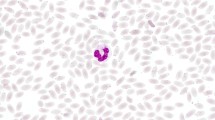Abstract:
Only 2/4 warm-blooded horses with inapparent stage of EIA showed thrombocytopenia (28, 85 G/l) and differential diagnosis with equine anaplasmosis should be done in Germany. The horses with inapparent form showed good body conditions, one-day fever until 40.5° C (3/4), few petechial hemorrhages in oral mucous membrane (1/4), mild anaemia (2/4) (6.5, 6.6 T/l), intravascular hemolysis (1/4) (2.34 μmol/l), but edema, anemic or icteric mucous membranes and hyperbilirubinemia were not found. 4/4 and 3/4 horses had high LDH (658 – 3300) and CK (484 – 1081) activities, 1/4 had high ASAT (751), GGT (14.9), GLDH (45 U/l), creatinine (230 μmol/l), hypoalbuminemia (22.7 g/l) and high BUN (2/4) (18.4, 6.9 mmol/l). A 5 years old pregnant mare imported from eastern Europe with chronic stage had poor performance, weight loss, moderate chest oedema, pale mucous membranes and petechial hemorrhages in vaginal vestibulum. Fever (39.3°C), tachycardia (84 /min), anemia (1.55 T/l), thrombocytopenia (98 G/l), hypoalbuminemia (16.6 g/l), hyperbilirubinemia (57 μmol/l) and high ASAT (822 U/l) and positive direct Coombs test were found. A 6 year old gelding with acute stage showed continuous fever (until 41.4°C, 12 days), depression, no appetite, no weight loss, mild chest edema, pale mucous membrane, bloody nasal discharge, wheezes, tachycardia (72/ min), anemia (1.66 T/l), hypoalbuminemia (22.0 g/l), very high LDH activity (2245), AST (486) and CK (316 U/l) and died suddenly. Coggins test was done for diagnosis and EIA infected horses were destroyed. Prevention: fly control, strict prevention of iatrogenic spread, annual testing, only allowance of seronegative horses at equestrian events.
Zusammenfassung:
Die Thrombozytopenie (28, 85 G/l) trat bei den Warmblutpferden mit inapparenter Form der EIA bei 50% der Fälle auf, daher ist differentialdiagnostisch in Deutschland die equine Anaplasmose zu berücksichtigen. Pferde mit inapparenter Form hatten einen guten Ernährungszustand, eintägiges Fieber bis 40,5° C (3/4), vereinzelt Petechien in der Mundschleimhaut (1/4), keine anämischen oder ikterischen Kopfschleimhäute und keine Ödeme. 2/4 Pferden hatten eine geringgradige Anämie (6,5; 6,6 T/l), 1/4 eine intravaskuläre Hämolyse (2,34 μmol/l), 0/4 eine Hyperbilirubinämie, 4/4 eine LDH- (658 – 3300), 3/4 eine CK- (484 – 1081), 1/4 eine ASAT- (751), je 1/4 GGT- (14,9) und GLDH-Aktivitätserhöhung (45 U/l), 1/4 eine Hypoalbuminämie (22,7 g/l), 2/4 erhöhte Harnstoff- (18,4; 6,9 mmol/ l) und 1/4 Kreatininkonzentrationen (230 μmol/l). Eine 5-jährige Stute mit chronischer Form, aus Osteuropa zugekauft, hatte hochgradige Leistungsschwäche, Abmagerung, mittelgradiges Unterbrustödem, porzellanweiße kopfschleimhäute, Petechien im Vestibulum vaginae, Fieber (39,3° C), Tachykardie (84/min), Anämie (1,55 T/l), Thrombozytopenie (98 G/l), positiven direkten Coombs Test, Hypoalbuminämie (16,6), Hyperbilirubinämie (57 μmol/l) und ASAT-Aktivitätserhöhung (822). Ein 6-jähriger Wallach mit akuter Form zeigte kontinuierliches Fieber über 12 Tage bis 41,4° C, Apathie, Inappetenz, keine Abmagerung, geringgradiges Unterbrustödem, porzellanweiße Kopfschleimhäute, blutigen Nasenausfluss, verschärft vesikuläres Atmungsgeräusch, Tachykardie (72/min), Anämie (1,66 T/l), Hypoalbuminämie (22,0), LDH- (2245), ASAT- (486) und CK-Aktivitätserhöhung (316 U/l) und verstarb plötzlich. Bei allen Pferden wurde mittels Coggins Testes die EIA diagnostiziert und die Bestände seuchenhygienisch saniert. Vorbeugung: Fliegenkontrolle, Verhinderung iatrogener Verbreitung, jährliche Testung, Zulassung zu Turnieren mit seronegativem Zeugnis.
Similar content being viewed by others
Author information
Authors and Affiliations
Corresponding author
Additional information
Eingegangen: 1. April 2008; angenommen: 7. April 2008
Rights and permissions
About this article
Cite this article
Schusser, G.F., Spallek, A., Börner, H. et al. Klinische und labormedizinische Befunde bei Pferden mit akuter, chronischer oder inapparenter Form der infektiösen Anämie. J. Verbr. Lebensm. 3, 405–410 (2008). https://doi.org/10.1007/s00003-008-0367-z
Published:
Issue Date:
DOI: https://doi.org/10.1007/s00003-008-0367-z




